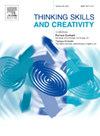地理虚拟现实(GVR):利用基于虚拟学习的元宇宙技术构建空间思维能力的创意材料
IF 3.7
2区 教育学
Q1 Social Sciences
引用次数: 0
摘要
技术、教学和知识之间的整合是学习地理的重要要求。这需要与时俱进的学习媒体的支持。这个时代的学习媒体更注重增强现实(Augmented Reality)、虚拟现实(Virtual Reality)等技术,让学生有一种直接看到物体的感觉。本文旨在开发基于 Geo-Virtual Reality 的元宇宙学习媒体。采用的方法是 ADDIE(分析、设计、开发、实施和评估),并进行了前测和后测,以检验媒体对学生空间思维能力的影响和效果。影响采用配对样本 T 检验,效果采用 N-增益得分分析。研究结果显示,sig < 0.05,表明地理虚拟现实(GVR)在学习中会影响学生的空间思维能力。同时,效果检验显示 N-Gain 为 0.47(中等水平),这表明该媒体可以提高学生的空间思维能力。然而,需要认识到的是,媒体的使用必须有教师的配合,教师必须掌握教学内容并能将其传达给学生,这样才能取得最佳效果。本文章由计算机程序翻译,如有差异,请以英文原文为准。
Geo-Virtual Reality (GVR): The creative materials to construct spatial thinking skills using virtual learning based metaverse technology
Integration between technology, pedagogic, and knowledge are an important requirement in learning geography. This requires support from learning media that adapts to the times. This era's learning media focuses more on Augmented Reality, Virtual Reality, and other technologies that give students the impression that they are seeing an object directly. This article aims to develop metaverse-based learning media in Geo-Virtual Reality. The method used is ADDIE (Analysis, Design, Development, Implementation and Evaluation)., a pre-test and post-test were carried out to test the influence and effectiveness of the media on students' spatial thinking skills. The influence was measured using the Paired Sample T-test, while the effectiveness was analyzed uses the N-Gain Score. The research results show sig < 0.05, indicating that Geo-Virtual Reality (GVR) in learning affects students' spatial thinking skills. Meanwhile, the effectiveness test shows an N-Gain of 0.47 (medium level), which shows that the media can improve students' spatial thinking skills. However, what needs to be realized is that the use of media must be accompanied by a teacher who masters the content and can convey it to students to obtain optimal results.
求助全文
通过发布文献求助,成功后即可免费获取论文全文。
去求助
来源期刊

Thinking Skills and Creativity
EDUCATION & EDUCATIONAL RESEARCH-
CiteScore
6.40
自引率
16.20%
发文量
172
审稿时长
76 days
期刊介绍:
Thinking Skills and Creativity is a new journal providing a peer-reviewed forum for communication and debate for the community of researchers interested in teaching for thinking and creativity. Papers may represent a variety of theoretical perspectives and methodological approaches and may relate to any age level in a diversity of settings: formal and informal, education and work-based.
 求助内容:
求助内容: 应助结果提醒方式:
应助结果提醒方式:


